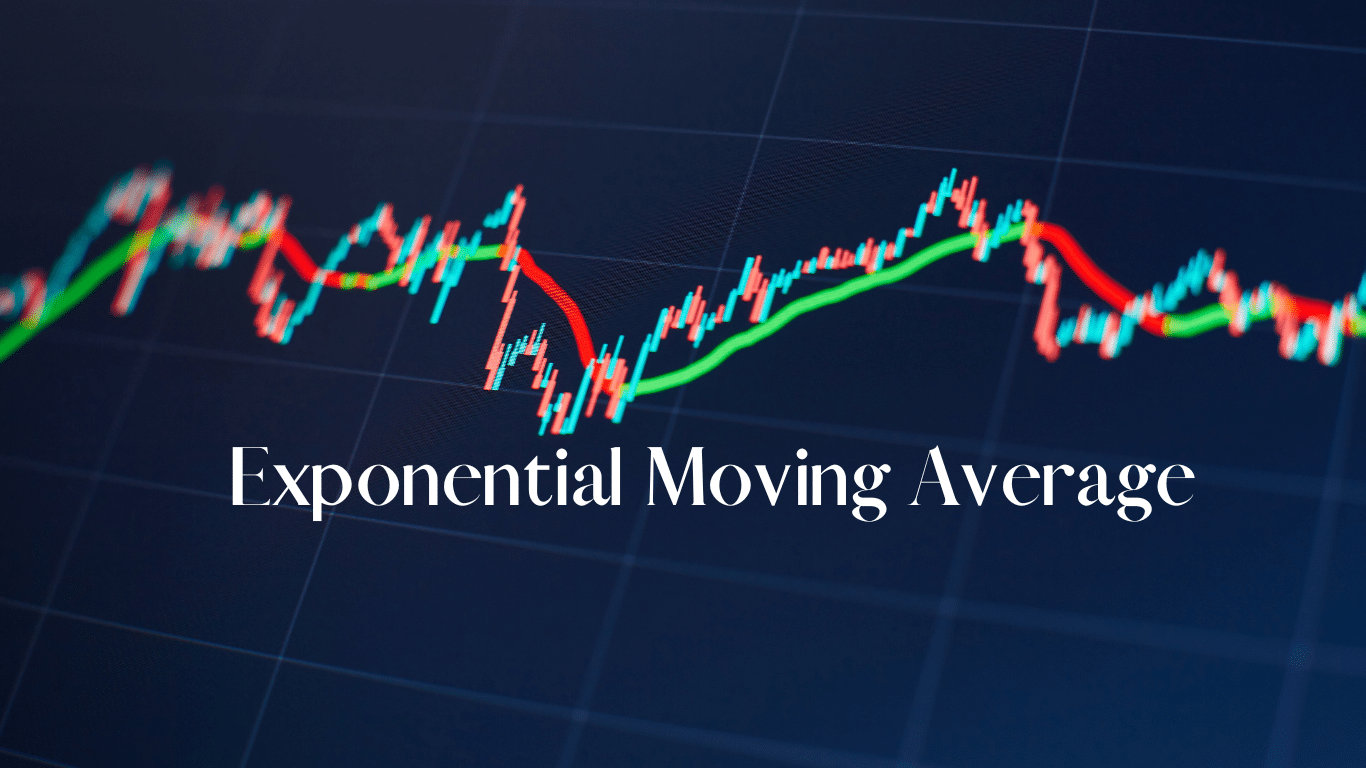An exponential moving average (EMA) assigns greater weight to a time series’s most recent data points. Its calculation takes into account the entire data series, but it emphasizes the importance of recent data by applying more weight to them than older data points. The weight applied to each data point decreases exponentially as you go back in time. This is in contrast to the Simple Moving Average (SMA), which assigns equal weight to each data point in the series.
It is calculated by taking a weighted average of the most recent data points, with the weight assigned to each data point determined by a smoothing factor or a parameter commonly referred to as alpha (α). The smoothing factor determines the rate at which the weight assigned to each data point decays over time.
It responds more quickly to changes in the underlying data than other moving averages, such as SMA or Weighted Moving Average (WMA), making it more sensitive to short-term price movements. This sensitivity can be helpful in detecting trend reversals or other short-term changes in a time series. Overall, this is a popular tool used in technical analysis to identify trends and potential entry and exit points in financial markets.

How is it calculated, and what factors affect its value?
The EMA is calculated by taking a weighted average of the most recent data points in a time series. The formula for calculating it is as follows:
EMA(current) = (α * Price(current)) + ((1 – α) * EMA(previous))
Where:
· EMA(current) is the current value.
· Price(current) is the current price or value in the time series
· EMA(previous) is the previous value.
· α is the smoothing factor or the weight assigned to the current price or value
The smoothing factor or alpha (α) is a value between 0 and 1 that determines the rate at which the weight assigned to each data point decays over time. A higher alpha value gives more weight to recent data points and results in a faster-changing EMA, while a lower alpha value gives more weight to older data points and results in a slower-changing EMA. The initial value is calculated using a simple moving average (SMA) of the first n data points, where n is the period of the EMA. After that, it is calculated using the formula above.
Factors that affect its value include:
- The number of data points used in the calculation.
- The value of alpha.
- The time frame of the time series being analyzed.
Changing any of these factors will affect the shape and position of the curve and its sensitivity to changes in the underlying data. Traders and analysts often experiment with different combinations of these factors to find the best values for their specific use case.
How is it used in technical analysis to identify trends and trading signals?

The exponential moving average (EMA) is a famous technical analysis tool traders use to identify trends and trading signals. Unlike simple moving averages (SMA), this gives more weight to recent price data, making it more responsive to changes in the market. It can be used to identify trends by plotting the moving average line on a chart and observing the direction of the line. If the price consistently trades above the EMA, it suggests an uptrend; if the price is consistently trading below the EMA, it indicates a downtrend.
Traders can also use this to generate trading signals. One common approach is to look for crossovers between different EMA lines. For example, a buy signal is generated when a shorter-term crosses above a longer-term EMA, indicating a bullish trend. In contrast, a sell signal is generated when a shorter-term crosses below a longer-term EMA, indicating a bearish trend.
It is often used with other technical indicators, such as Relative Strength Index (RSI) and Moving Average Convergence Divergence (MACD), to confirm signals and improve the accuracy of trades. RSI is a momentum oscillator measures speed and change of price movements, while MACD is a trend-following momentum indicator that tracks the relationship between two moving averages.
While RSI and MACD use different calculations and approaches compared to EMA, they can still be used in conjunction with it to provide a more comprehensive market analysis. For example, traders may use EMA crossovers in conjunction with RSI to identify potential overbought or oversold conditions, or combine MACD with it to confirm trend changes and generate trading signals.
How do traders use this with other technical indicators, such as the RSI and MACD?
Traders often use this indicator in conjunction with other technical indicators, such as the Relative Strength Index (RSI) and Moving Average Convergence Divergence (MACD), to improve the accuracy of their trading signals and confirm potential trend changes.
One common approach is using EMA crossovers with RSI to identify potential overbought or oversold conditions. For example, if the price is trading above the EMA and the RSI is above 70, it could suggest that the asset is overbought and due for a pullback. Conversely, if the price is trading below the EMA and the RSI is below 30, it could suggest that the asset is oversold and due for a bounce.
Traders may also use MACD with this indicator to confirm trend changes and generate trading signals. Traders may use it as a trailing stop loss to protect their profits if the trend reverses.
Another approach is to use multiple EMAs with different time frames in conjunction with other technical indicators. For example, a trader may use a short-term EMA (e.g. 10-day) and a long-term EMA (e.g., 50-day) along with the MACD and RSI. If the short-term EMA crosses above the long-term EMA and the MACD and RSI confirm a bullish trend, it could signal a strong buy signal.
Overall, using this indicator with other technical indicators can help traders identify potential trading opportunities and improve their chances of success in the market. However, it is essential to note that no single indicator or approach can guarantee profitable trades. Traders should always conduct thorough analysis and risk management strategies before making any investment decisions.
What are the advantages and disadvantages of using this in trading strategies?

The advantages of using the Exponential Moving Average in trading strategies include:
- Responsiveness: It gives more weight to recent price data, making them more responsive to changes in the market compared to Simple Moving Averages (SMA).
- Trend identification: It can help identify trends and potential trend changes, making them a useful tools for traders to make informed trading decisions.
- Versatility: It can be used in different time frames and asset classes, making them versatile tools for traders in various markets.
- Trading signals: It can be used to generate trading signals, such as crossovers between different EMA lines, which can help traders make profitable trades.
However, there are also some disadvantages to using it in trading strategies, including:
- It can generate false signals in choppy or ranging markets, leading to potential losses for traders.
- Lagging – Although it is more responsive than SMAs, it can still lag behind the current price, potentially causing traders to miss out on profitable trading opportunities.
- Complexity – Using multiple EMAs with different time frames and other technical indicators can make trading strategies more complex and challenging to manage, requiring traders to have advanced knowledge and skills.
- Over-reliance – Over-reliance on any single indicator, including EMA, can lead to biases and potential losses for traders if market conditions change unexpectedly.
In summary, while this can be a useful tool for traders to identify trends and generate trading signals, it is important not to soley rely on this indicator but rather use it with other indicators for better results.
All you need to know about the Average Directional Index:

